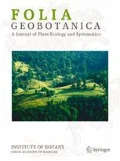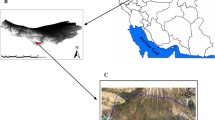Abstract
Species richness in vascular plants was related to the plants’ calcifuge or calcicole behaviour using documentation from forests and open-land vegetation at about one thousand sites in the southern parts of Sweden. It is concluded that vegetation of strongly acid soils (pH-KCl < 4.5) have fewer vascular plant species than comparable vegetation of other soils, whereas there are no consistent differences in species richness between slightly-moderately acid and calcareous sites. Low species richness is particularly related to high concentrations of Al3+ and H+ ions (either soil solution concentrations or concentrations of exchangeable ions), not to a lack of calcium carbonate. The majority of plant species are able to render the sparingly soluble phosphate, iron and manganese compounds of high-pH soils available, but they are unable to tolerate much Al3+ or H+. Acidicole (calcifuge) species have developed the power of tolerating Al3+ and H+, which may be considered a secondary property of plants, but they have lost the power of solubilizing critical mineral nutrients in high-pH soils. The reasons why these ecophysiological properties are inversely related in the current flora are obscure, difficult to account for experimentally and a main ecological problem. In areas with cool-temperate climates the flora was partly or mainly extinguished by the Pleistocene glaciations. Comparatively fewer calcifuge than calcicole species have, since then, had enough time to develop, and the number of calcifuges is lower, in spite of the fact that most natural and seminatural soils of these areas are nowadays acidic.
Similar content being viewed by others
References
Adams F. &Hathcock P.J. (1984): Aluminium toxicity and calcium deficiency in acid subsoil horizons of two coastal plains soil series.J. Soil Sci. Soc. Amer. 48: 1305–1309.
Andersson M. (1992): Effects of pH and aluminium on growth ofGalium odoratum (L.)Scop. in flowing solution culture.Environm. Exp. Bot. 32: 497–504.
Andersson M.E. (1993): Aluminium toxicity as a factor limiting the distribution ofAllium ursinum L.Ann. Bot. (Oxford) 72: 607–611.
Andersson M.E. &Brunet J. (1993): Sensitivity to H and Al ions limiting growth and distribution of the woodland grassBromus benekenii.Pl. & Soil 153: 243–254.
Ellenberg H. (1992): Zeigerwerte der Gefässpflanzen (ohneRubus).Scripta Geobot. 18: 9–166.
Ewald J. (2003): The calcareous riddle: Why are there so many calciphilous species in the Central European flora?Folia Geobot. 38: 357–366 (this issue).
Falkengren-Grerup U. &Tyler G. (1993a): Soil chemical properties excluding field-layer species from beech forest mor.Pl. & Soil 148: 185–191 (Errata in 150: 323).
Falkengren-Grerup U. &Tyler G. (1993b): The importance of soil acidity, moisture, exchangeable cation pools and organic matter solubility to the cationic composition of beech forest (Fagus sylvatica L.) soil solution.Z. Pflanzenernähr. Bodenk. 156: 365–370.
Gries D. &Runge M. (1992): The ecological significance of iron mobilization in wild grasses.J. Pl. Nutr. 15: 1727–1737.
Gries D. &Runge M. (1995): Responses of calcicole and calcifugePoaceae species to iron-limiting conditions.Bot. Acta 108: 482–489.
Jones D.L. (1998): Organic acids in the rhizophere — a critical review.Pl. & Soil 205: 25–44.
Kinraide T. B. (1991): Identity of the rhizotoxic aluminium species.Pl. & Soil 134: 167–178.
Lee J.A. (1999): The calcicole-calcifuge problem revisited.Advances Bot. Res. 29:1–30.
Marschner H. (1991): Mechanisms of adaptation of plants to acid soils.Pl. & Soil 134: 1–20.
Marschner H. &Kissel M. (1986): Different strategies in higher plants in mobilization and uptake of iron.J. Pl. Nutr. 9: 695–713.
Rengel Z. (1992): Role of calcium in aluminium toxicity.New Phytol. 121: 499–513.
Schöttelndreier M., Norddahl M.M., Ström L. &Falkengren-Grerup U. (2001): Organic acid exudation by wild herbs in response to elevated Al concentrations.Ann. Bot. (Oxford) 87: 769–775.
Ström L. (1997): Root exudation of organic acids — importance to nutrient availability and the calcifuge and acidifuge behaviour of plants.Oikos 80: 459–466.
Tyler G. (1989a): The interacting effects of soil acidity and canopy cover on the species composition of field-layer vegetation in oak-hornbeam forest.Forest Ecol. Managem. 28: 101–114.
Tyler G. (1989b): Edaphical distribution patterns of macrofungal species in deciduous forest of south Sweden.Acta Oecol., Oecol. Gen. 10: 309–326.
Tyler G. (1992): Inability to solubilize phosphate in limestone soils — key factor controlling calcifuge behaviour of plants.Pl. & Soil 45: 65–70.
Tyler G. (1993): Soil solution chemistry controlling the field distribution ofMelica ciliata L.Ann. Bot. (Oxford) 71: 295–301.
Tyler G. (1994): A new approach to understanding the calcifuge habit of plants.Ann. Bot. (Oxford) 73: 327–330.
Tyler G. (1996): Soil chemistry and plant distributions in rock habitats of southern Sweden.Nord. J. Bot. 16: 609–635.
Tyler G. (2000): Integrated analysis of conditions accounting for intersite distribution of grassland plants.Nord. J. Bot. 20: 485–500.
Tyler G. &Ström L. (1995): Differing organic acid exudation pattern explains calcifuge behaviour of plants.Ann. Bot. (Oxford) 75: 75–78.
Tyler G. &Falkengren-Grerup U. (1998): Soil chemistry and plant performance — Ecological considerations.Progr. Bot. 59: 634–658.
van Aarle I.M. (2002):The ecophysiology of arbuscular mycorrhizal fungi: Phosphatase activity associated with extraradical and intraradical mycelium. Doctoral thesis, Department of Ecology, Microbial Ecology, Lund University, Lund.
van der Heijden M.G.A., Klironomos J.N., Ursic M., Moutoglis P., Streitwolf-Engel R., Boller T., Wiemken A. &Sanders I.R. (1998): Mycorrhizal fungal diversity determines plant biodiversity, ecosystem variability and productivity.Nature 396: 69–72.
Zohlen A. (2002): Chlorosis in wild plants: is it a sign of Fe deficiency?J. Pl. Nutr. 25: 2205–2228.
Zohlen A. &Tyler G. (2000): Immobilization of tissue iron on calcareous soil — differences between calcicole and calcifuge plants.Oikos 89: 95–106.
Author information
Authors and Affiliations
Corresponding author
Rights and permissions
About this article
Cite this article
Tyler, G. Some ecophysiological and historical approaches to species richness and calcicole/calcifuge behaviour — contribution to a debate. Folia Geobot 38, 419–428 (2003). https://doi.org/10.1007/BF02803249
Received:
Revised:
Accepted:
Issue Date:
DOI: https://doi.org/10.1007/BF02803249




